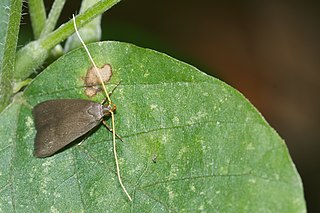
The Lecithocerinae are a subfamily of small moths in the family Lecithoceridae. They are found worldwide, but most species occur in South Asia. The subfamily is characterized by the male genitalia with a bridge-like structure connecting the tegumen and the valva, and the uncus almost always is vestigial with two lobes at the dorsal base, only exceptionally united into a broad plate, but never as a thorn or spine.

Carodista is a genus of moths in the family Lecithoceridae. The genus was erected by Edward Meyrick in 1925.

Homaloxestis is a genus of moths in the family Lecithoceridae. The genus was erected by Edward Meyrick in 1910.

Lecithocera is a genus of moths in the lecithocerid subfamily Lecithocerinae. The genus was erected by Gottlieb August Wilhelm Herrich-Schäffer in 1853.
Lecithocera acrosphales is a moth in the family Lecithoceridae. It was described by Edward Meyrick in 1918. It is found on Madagascar.
Lecithocera frustrata is a moth in the family Lecithoceridae. It was described by Edward Meyrick in 1918. It is found in the Central African Republic.
Lecithocera trifera is a moth in the family Lecithoceridae. It was described by Edward Meyrick in 1938. It is found in the former Orientale Province of the Democratic Republic of the Congo.
Lecithocera autodyas is a moth in the family Lecithoceridae. It was described by Edward Meyrick in 1929. It is found on New Ireland.
Lecithocera baeopis is a moth in the family Lecithoceridae. It was described by Edward Meyrick in 1929. It is found in Assam, India.
Lecithocera carcinopsis is a moth in the family Lecithoceridae. It was described by Edward Meyrick in 1929. It is found in southern India.
Lecithocera cratophanes is a moth in the family Lecithoceridae. It was described by Edward Meyrick in 1929. It is found in southern Vietnam.
Lecithocera crypsigenes is a moth in the family Lecithoceridae. It was described by Edward Meyrick in 1929. It is found in Sri Lanka.
Lecithocera eumenopis is a moth in the family Lecithoceridae. It was described by Edward Meyrick in 1914. It is found in northern Australia.
Lecithocera phratriastis is a moth in the family Lecithoceridae. It was described by Edward Meyrick in 1929. It is found in Sri Lanka.
Lecithocera protoma is a moth in the family Lecithoceridae. It was described by Edward Meyrick in 1914. It is found in Ghana.
Lecithocera sceptrarcha is a moth in the family Lecithoceridae. It was described by Edward Meyrick in 1920. It is found in Kenya.
Lecithocera squamifera is a moth in the family Lecithoceridae. It was described by Edward Meyrick in 1929. It is found on New Hanover Island in Papua New Guinea.
Lecithocera stomobapta is a moth in the family Lecithoceridae. It was described by Edward Meyrick in 1929. It is found in southern India.
Lecithocera olinxana is a moth in the family Lecithoceridae. It was described by Chun-Sheng Wu and You-Qiao Liu in 1993. It is found in Anhui, China.



